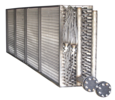Making sure your commercial HVAC system is ready for summer

Now is a great time to make sure your commercial HVAC system is ready to handle spring and summer cooling. Evaluating your evaporator coil and condenser coils is part of the process.
The evaporator and condenser coils inside a central air conditioner or heat pump facilitate the heat exchange process, which is the basis of refrigerated cooling and, in the case of heat pumps, heating. Refrigerant circulates on a continuous loop between the evaporator coil and condenser coil.
As you probably know, the evaporator coil is located inside or near the air handler where the blower fan is. The condenser coil is located outside in the condenser unit, which also contains the compressor, a fan and copper tubing, as well as valves and switches. Condenser coils come in a variety of shapes, but for most central air conditioning systems, the condenser coil wraps around the sides of the outdoor condenser unit.The evaporator coil works with your heating system in the winter and your cooling system in the summer. Evaporator coils are made from copper, steel or aluminum because these metals conduct heat easily. The evaporate coil operates with the air conditioner or heat pump to condition and cool indoor air that flows over it by removing moisture and heat. In winter, the heat pump pulls air in from the outside and runs the air over the evaporator coil. The colder air is warmed by the evaporator coil and then pumped through the ductwork to heat the building. Even if the air outside the building is below freezing, the HVAC system is able to pull some heat from it.The first sign there may be a problem with the condenser coil is when the temperature of the cooled air is warmer than the thermostat setting. Check the amount of refrigerant in the system to make sure there is enough coolant. If the coolant level is OK, it might be time to replace the condenser coil. Check your local guidelines to learn about the proper disposal of old condenser coils.Also check for leaks in your evaporator coils if the refrigerant level is low. Corrosion from building materials, furniture and common cleaning solutions that produce fumes called volatile organic compounds (VOCs) can cause the evaporator coils to leak.Contact our coil experts at 1-855-Coil-Now or sales@emergentcoils.com if your commercial HVAC system needs new or replacement condenser and evaporator coils.
